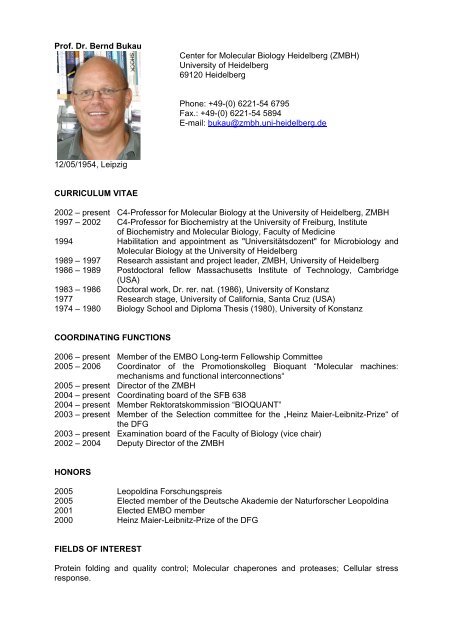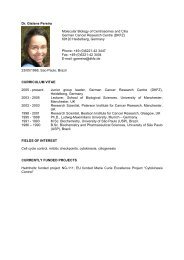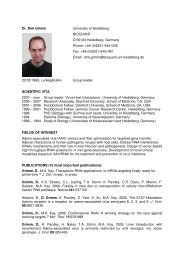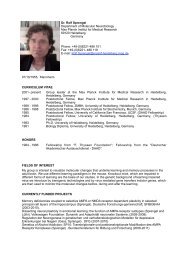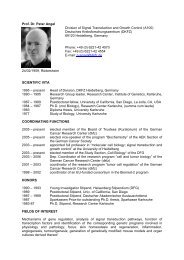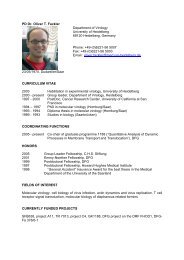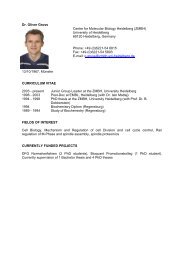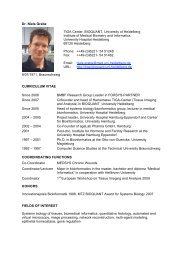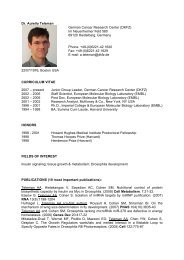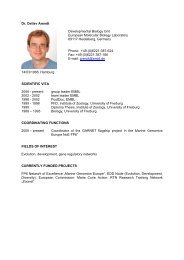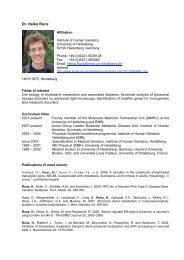Prof. Dr. Bernd Bukau Center for Molecular Biology ... - HBIGS
Prof. Dr. Bernd Bukau Center for Molecular Biology ... - HBIGS
Prof. Dr. Bernd Bukau Center for Molecular Biology ... - HBIGS
Create successful ePaper yourself
Turn your PDF publications into a flip-book with our unique Google optimized e-Paper software.
<strong>Prof</strong>. <strong>Dr</strong>. <strong>Bernd</strong> <strong>Bukau</strong><br />
<strong>Center</strong> <strong>for</strong> <strong>Molecular</strong> <strong>Biology</strong> Heidelberg (ZMBH)<br />
University of Heidelberg<br />
69120 Heidelberg<br />
Phone: +49-(0) 6221-54 6795<br />
Fax.: +49-(0) 6221-54 5894<br />
E-mail: bukau@zmbh.uni-heidelberg.de<br />
12/05/1954, Leipzig<br />
CURRICULUM VITAE<br />
2002 – present C4-<strong>Prof</strong>essor <strong>for</strong> <strong>Molecular</strong> <strong>Biology</strong> at the University of Heidelberg, ZMBH<br />
1997 – 2002 C4-<strong>Prof</strong>essor <strong>for</strong> Biochemistry at the University of Freiburg, Institute<br />
of Biochemistry and <strong>Molecular</strong> <strong>Biology</strong>, Faculty of Medicine<br />
1994 Habilitation and appointment as "Universitätsdozent" <strong>for</strong> Microbiology and<br />
<strong>Molecular</strong> <strong>Biology</strong> at the University of Heidelberg<br />
1989 – 1997 Research assistant and project leader, ZMBH, University of Heidelberg<br />
1986 – 1989 Postdoctoral fellow Massachusetts Institute of Technology, Cambridge<br />
(USA)<br />
1983 – 1986 Doctoral work, <strong>Dr</strong>. rer. nat. (1986), University of Konstanz<br />
1977 Research stage, University of Cali<strong>for</strong>nia, Santa Cruz (USA)<br />
1974 – 1980 <strong>Biology</strong> School and Diploma Thesis (1980), University of Konstanz<br />
COORDINATING FUNCTIONS<br />
2006 – present Member of the EMBO Long-term Fellowship Committee<br />
2005 – 2006 Coordinator of the Promotionskolleg Bioquant “<strong>Molecular</strong> machines:<br />
mechanisms and functional interconnections“<br />
2005 – present Director of the ZMBH<br />
2004 – present Coordinating board of the SFB 638<br />
2004 – present Member Rektoratskommission “BIOQUANT”<br />
2003 – present Member of the Selection committee <strong>for</strong> the „Heinz Maier-Leibnitz-Prize“ of<br />
the DFG<br />
2003 – present Examination board of the Faculty of <strong>Biology</strong> (vice chair)<br />
2002 – 2004 Deputy Director of the ZMBH<br />
HONORS<br />
2005 Leopoldina Forschungspreis<br />
2005 Elected member of the Deutsche Akademie der Natur<strong>for</strong>scher Leopoldina<br />
2001 Elected EMBO member<br />
2000 Heinz Maier-Leibnitz-Prize of the DFG<br />
FIELDS OF INTEREST<br />
Protein folding and quality control; <strong>Molecular</strong> chaperones and proteases; Cellular stress<br />
response.
CURRENTLY FUNDED PROJECTS<br />
DFG-project on Mechanisms of the interaction between cytosolic proteases of E. coli and<br />
substrates; DFG-project on Mechanism and protein disaggregation by the AAA+ chaperone<br />
ClpB; SFB 638 project A1; DFG-SPP 1132; Promotionskolleg Bioquant; VCI; Boehringer<br />
Ingelheim Fonds; Alexander von Humboldt Foundation; EMBO; industry-support.<br />
PUBLICATIONS (10 selected publications)<br />
Erbse A, Schmidt R, Bornemann T, Schneider-Mergener J, Mogk A, Zahn R, Dougan DA,<br />
<strong>Bukau</strong> B (2006) ClpS is an essential component of the N-end rule pathway in Escherichia<br />
coli. Nature 439: 753-756.<br />
Vogel M, <strong>Bukau</strong> B, Mayer MP (2006) Allosteric regulation of Hsp70 chaperones by a proline<br />
switch. Mol Cell 21: 359-367.<br />
Weibezahn J, Tessarz, Schlieker C, Zahn R, Maglica Z, Lee S, Zentgraf H, Weber-Ban E,<br />
Dougan D, Tsai FTF, Mogk A, <strong>Bukau</strong> B. (2004) Thermotolerance requires refolding of<br />
aggregated proteins by substrate translocation through the central pore of ClpB. Cell 119:<br />
653-665.<br />
Ferbitz L, Maier T, Patzelt H, <strong>Bukau</strong> B, Deuerling E, Ban N (2004) Structure of the Trigger<br />
Factor chaperone complex with the ribosome defines the molecular environment of the<br />
emerging nascent protein chain. Nature 431: 590-596.<br />
Dougan DA, Weber-Ban E, <strong>Bukau</strong> B (2003) Targeted delivery of an ssrA-tagged substrate by<br />
the adaptor protein SspB to its cognate AAA+ protein ClpX. Mol Cell 12: 373-380.<br />
Kramer G, Rauch T, Rist W, Vorderwülbecke S, Patzelt H, Schulze-Specking A, Ban N,<br />
Deuerling E, <strong>Bukau</strong> B (2002) L23 protein functions as a chaperone docking site on the<br />
ribosome. Nature 419: 171-174.<br />
Dougan DA, Reid BG, Horwich AL, <strong>Bukau</strong> B (2002) ClpS, a substrate modulator of the<br />
ClpAP machine. Mol Cell 9: 673-683.<br />
Brehmer D, Rüdiger S, Gässler CS, Klostermeier D, Packschies L, Reinstein J, Mayer MP,<br />
<strong>Bukau</strong> B (2001) Tuning of chaperone activity of Hsp70 proteins by modulation of nucleotide<br />
exchange. Nat Struct Biol 8: 427-432.<br />
Mayer MP, Schröder H, Rüdiger S, Paal K, Laufen T, <strong>Bukau</strong> B (2000) Multistep mechanism<br />
of substrate binding determines chaperone activity of Hsp70. Nat Struct Biol 7: 586-953.<br />
Deuerling E, Schulze-Specking A, Tomoyasu T, Mogk A, <strong>Bukau</strong> B (1999) Trigger factor and<br />
DnaK cooperate in folding of newly synthesized proteins. Nature 400: 693-696
EXPERIENCE IN THE SUPERVISION OF DOCTORAL CANDIDATES<br />
Member of numerous thesis and thesis advisory committees<br />
International reviewer of doctoral theses<br />
Supervised 26 doctoral theses<br />
SUPERVISED DISSERTATIONS (last 5 years)<br />
Holger Raviol, PhD (2006) Functional characterization of the Hsp110 family of molecular<br />
chaperones. University of Heidelberg<br />
Current occupation: Research Scientist, Roche Diagnostics, Mannheim<br />
Jimena Weibezahn, PhD (2006) Investigation of the mechanism of protein disaggregation by<br />
the AAA+ protein ClpB. University of Heidelberg<br />
Current occupation: Postdoctoral fellow, Howard Hughes Medical Institute, UC San<br />
Francisco, USA<br />
Christine Strub, MD (2005) Untersuchungen zur Struktur und Substratspezifität des AAA+-<br />
Chaperons ClpB in Escherichia coli. University of Freiburg<br />
Current occupation: Medical doctor at hospital<br />
Thomas Rauch, PhD (2005) The role of ribosome-associated chaperones in de novo protein<br />
folding. University of Heidelberg, Ruprecht-Karls Prize 2006<br />
Current occupation: Medical Student, University of Heidelberg<br />
Wolfgang Rist, PhD (2004) Mass spectrometric analysis of chaperone-substrate interactions.<br />
University of Heidelberg<br />
Current occupation: Research Scientist, Boehringer Ingelheim Pharma, Biberach<br />
Christian Schlieker, PhD (2004) Substrate recognition and processing by the AAA+<br />
chaperone ClpB. University of Heidelberg, Ruprecht-Karls Prize 2005<br />
Current occupation: Postdoctoral fellow, Harvard Medical School, Boston, USA<br />
Tilman Schlothauer, PhD (2004) Role of the MecA adaptor protein in regulation of AAA+<br />
chaperone ClpC of Bacillus subtilis. University of Heidelberg<br />
Current occupation: Research Scientist, Roche Diagnostics, Penzberg<br />
Sonja Vorderwülbecke, PhD (2003) Struktur-Funktionsanalyse von Trigger Faktor, einem<br />
Ribosomen-assoziierten Chaperon aus Escherichia coli. University of Freiburg<br />
Current occupation: Research Scientist, BioRad, Munich<br />
Christoph Kluck, PhD (2003) Alternative Hsp70-Systeme in Escherichia coli. University of<br />
Heidelberg<br />
Current occupation: Postdoctoral fellow, University of Erlangen-Nürnberg<br />
Holger Patzelt, PhD (2003) Structural and functional characterization of Trigger Factor, a<br />
ribosome-associated chaperone in Escherichia coli. University of Heidelberg,<br />
VAAM Promotion Prize 2004<br />
Current occupation: Senior Research Fellow, Max Planck Institute of Economics,<br />
Jena


